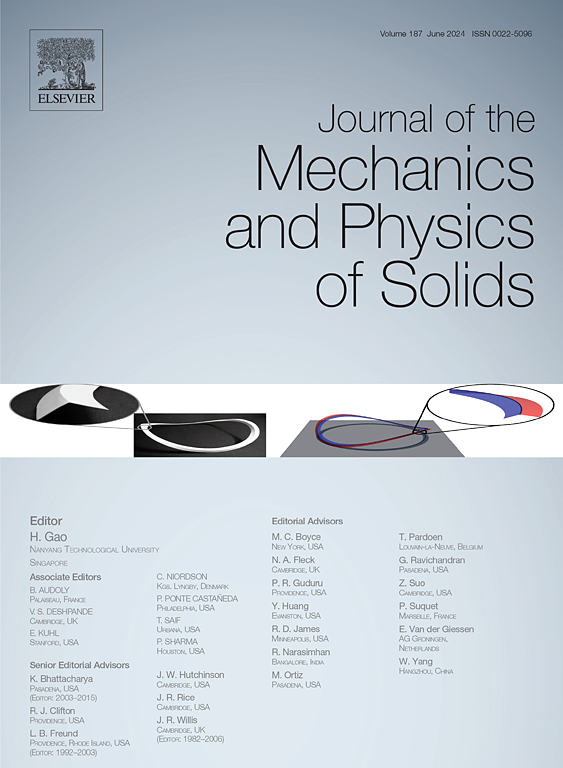孔洞尺寸分布不均匀的多孔延性固体的有限元模拟
IF 6
2区 工程技术
Q2 MATERIALS SCIENCE, MULTIDISCIPLINARY
引用次数: 0
摘要
在这项研究中,我们使用基于微观力学的模型来研究非均匀孔隙尺寸分布对多孔延性固体塑性流动和断裂行为的影响。我们使用两种不同的建模方法对包含3 × 3到22 × 22不等大小的均匀间隔孔洞的统计体积元进行二维平面应变有限元模拟:(i)在空间上解析孔洞;(ii)使用多孔塑性模型并在空间上改变初始孔隙率。对于每种样本量,通过从对数正态空隙尺寸分布中随机抽样生成30个统计体积元,以量化给定数量空隙的变化。分析了不同施加应力状态下的宏观行为和微观组织演变。我们的研究结果表明,不均匀的孔隙尺寸对初始屈服和峰值应力前的行为的影响可以忽略不计,但达到最大应力时的应变是不同的。在峰值应力之外,统计体积元之间的宏观应力-应变响应和空隙生长存在显著差异。随着样本量的增加,平均破坏应变减小,散点减小,但即使是大样本量,在破坏应变中仍保持散点。我们使用具有多孔塑性的模型实现了巨大的加速,同时产生的结果与具有空间分辨空隙的模型相当。这表明,使用多孔塑性模型和空间变化的初始孔隙率来描述模型的空洞子区域的一种经济有效的建模方法,有助于模拟具有统计代表性空洞数量的三维体积单元。本文章由计算机程序翻译,如有差异,请以英文原文为准。
Finite element modeling of porous ductile solids with non-uniform void size distributions
In this study, we use micromechanics-based modeling to investigate the effect of a non-uniform void size distribution on the plastic flow and fracture behavior of porous ductile solids. We perform 2D plane strain finite element simulations of statistical volume elements containing between 3 × 3 and 22 × 22 uniformly-spaced voids of varying sizes, using two different modeling approaches: (i) resolving the voids spatially and (ii) using a porous plasticity model and spatially varying the initial porosity. For each sample size, thirty statistical volume elements are generated through random sampling from a log-normal void size distribution to quantify the variation for a given number of voids. The macroscopic behavior and microstructural evolution are analyzed under different imposed stress states. Our findings indicate that non-uniform void sizes have negligible effects on initial yielding and behavior before peak stress, but the strain at which maximum stress is attained varies. Beyond peak stress, there is a significant variation in the macroscopic stress–strain response and void growth between the statistical volume elements. Mean failure strain decreases and scatter diminishes as sample size increases, but even large samples retain scatter in failure strain. We achieve tremendous speed-up using models with porous plasticity while producing results comparable to models with spatially resolved voids. This suggests that a cost-effective modeling approach, where the voided subregions of the model are described using a porous plasticity model and spatially varying initial porosity, facilitates simulations of 3D volume elements with a statistically representative number of voids.
求助全文
通过发布文献求助,成功后即可免费获取论文全文。
去求助
来源期刊
CiteScore
9.80
自引率
9.40%
发文量
276
审稿时长
52 days
期刊介绍:
The aim of Journal of The Mechanics and Physics of Solids is to publish research of the highest quality and of lasting significance on the mechanics of solids. The scope is broad, from fundamental concepts in mechanics to the analysis of novel phenomena and applications. Solids are interpreted broadly to include both hard and soft materials as well as natural and synthetic structures. The approach can be theoretical, experimental or computational.This research activity sits within engineering science and the allied areas of applied mathematics, materials science, bio-mechanics, applied physics, and geophysics.
The Journal was founded in 1952 by Rodney Hill, who was its Editor-in-Chief until 1968. The topics of interest to the Journal evolve with developments in the subject but its basic ethos remains the same: to publish research of the highest quality relating to the mechanics of solids. Thus, emphasis is placed on the development of fundamental concepts of mechanics and novel applications of these concepts based on theoretical, experimental or computational approaches, drawing upon the various branches of engineering science and the allied areas within applied mathematics, materials science, structural engineering, applied physics, and geophysics.
The main purpose of the Journal is to foster scientific understanding of the processes of deformation and mechanical failure of all solid materials, both technological and natural, and the connections between these processes and their underlying physical mechanisms. In this sense, the content of the Journal should reflect the current state of the discipline in analysis, experimental observation, and numerical simulation. In the interest of achieving this goal, authors are encouraged to consider the significance of their contributions for the field of mechanics and the implications of their results, in addition to describing the details of their work.

 求助内容:
求助内容: 应助结果提醒方式:
应助结果提醒方式:


